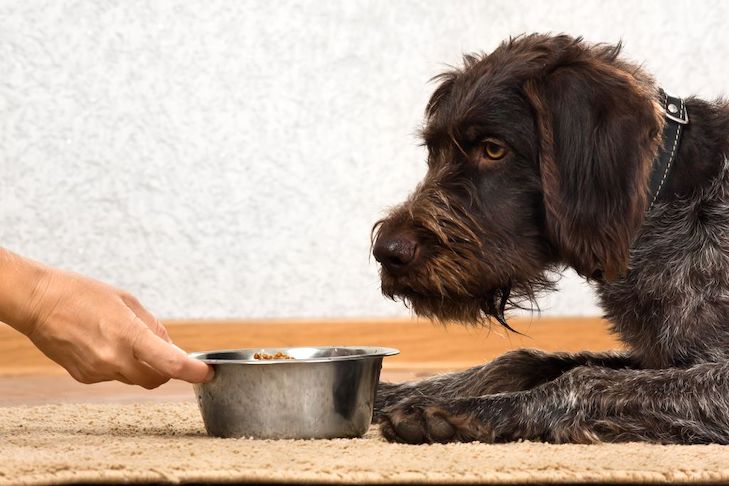Are you considering switching your dog to a homemade diet? A good place to begin is by discussing it with your veterinarian and/or a veterinary nutritionist. You may think that sounds unnecessary when there are so many recipes for homecooked dog meals available on the internet. However, the experts say that many of those recipes were not reviewed by veterinary nutritionists to make sure they provide a nutritional, well-balanced diet for your dog. This is why some owners prefer to feed pre-made fresh food.
The American College of Veterinary Nutrition (ACVN) warns that your dog’s unique nutritional requirements will depend on the age, size, health, and breed. Also, there are dogs for whom a homemade diet may not be appropriate or might even be damaging. “We generally don’t recommend homemade diets for a dog less than one-year-old. If young dogs don’t receive the appropriate amount of calcium and phosphorus, significant bone abnormalities may result,” says Dr. Jerry Klein, AKC chief veterinarian. “Pregnant and lactating dogs also have unique dietary requirements that may not be addressed by a recipe found on the internet.”
The ABCs of a Balanced Dog Food Diet
Understanding the basics of what makes a homecooked diet balanced for your dog will help when you discuss the options with an expert. Here are important ingredients for the canine diet.
Protein: According to the ACVN, dogs must have protein in their diets that contain 10 specific essential amino acids their bodies can’t produce. This is necessary for the creation of glucose, which transforms into energy. Sources of protein include chicken and turkey, after removing bones, fat, and skin; beef and lamb; pork in limited amounts; salmon and some other fish such as whitefish, herring, walleye, flounder, and Arctic char.
Fats and fatty acids: The most concentrated sources of fats in a dog’s diet come from animal fats and plant seed oils. A healthy diet supplies the fatty acids the dog’s body doesn’t manufacture. Fatty acids support the function and structure of cells, keep skin and coat healthy, and enhance the taste of the food. Sources of fatty acids include plant-based oils, including corn, soybean, canola, and flaxseed oil, as well as fish oil.
Carbohydrates: Dogs get some of their energy from carbohydrates, which include sugars, starches, and dietary fibers. Sources include rice, pasta, oatmeal, and quinoa.
Fiber: Dogs need fiber in their diet to keep their gastrointestinal (GI) system functioning and to help them from becoming overweight. Good sources of fiber for dogs include carrots, pumpkin, apples, dark leafy greens, brown rice, and flaxseed.
Vitamins: Vitamins are required for growth and maintenance. Vitamin deficiencies can cause a variety of health problems; however, they can also be dangerous in large quantities.
Vitamins dogs require include A (carrots, pumpkin), B vitamins (liver, green vegetables, whole grains), C (fruits and vegetables, organ meat), D (liver, fish, beef), E (leafy green vegetables, liver, bran, plant oils), K (fish, leafy green vegetables, fish), and choline (liver, fish, meats, egg yolks).
Minerals: There are 12 essential minerals for dogs:
Calcium (tofu, green beans, broccoli, and cauliflower) and phosphorus (meat, eggs) for strong bones and teeth. Magnesium, potassium, sodium, and chloride (fruits, vegetables, whole grains) for nerve impulse transmission, muscle contraction, and cell signaling. Sulfur (meat, fish, molasses) for healthy skin, coat, and nails. Iron (red meats, poultry) for supporting red blood cells and the immune system. Iodine (dairy, kelp, seafood) for a healthy thyroid. Zinc (eggs, lamb, liver, brewer’s yeast) for the immune system, healthy skin, and coat. Selenium (meat, vegetables, seafood, brown rice) to boost the immune system. Copper (whole grains, seeds, and seafood) for healthy bone growth.
Water: We sometimes overlook this important ingredient of a healthy dog’s diet, but there really is no dog food that contains enough water for your dog. Keep clean, fresh water out always.
Making the Transition
Consult a veterinarian: If you’ve decided to transition your dog to a homemade diet, your first step should be to consult a veterinarian or veterinary nutritionist. Those experts will consider your dog’s age, size, and health history and help you identify a high-quality recipe that is tailored to meet your dog’s specific nutritional needs.
Buying ingredients: When you buy ingredients for your dog’s homemade meals, you need to pay as much attention to the source, expiration dates, and labels as you do when you buy food for yourself.
Making the switch gradually: Whenever you change your dog’s food, whether to a homemade diet or a new commercial food, a gradual switch is best to avoid upsetting your dog’s GI system. For at least five-to-seven days, gradually mix in more and more of the new food with the old food, as you allow your dog to adjust to the change.
Follow the recipe: Be sure to follow the recipe. Tufts Cummings Veterinary Medical Center Clinical Nutrition Service published a study to determine how well owners adhered to homecooked diet recipes a median of one year later. Only 13 percent were still feeding the original nutritionally balanced diet recipe.
Clear instructions: Instructions about preparation and quantities are important. The way you cook the ingredients – for example, steam, roast, or boil — can impact the nutrition of the diet. Substituting or adding ingredients can also cause nutritional deficiencies. A study reported in the Journal of the American Veterinary Medical Association reported that a lack of clear instructions in many recipes forces pet owners to make assumptions that can result in food that is nutritionally inadequate and can even be harmful if fed to your dog on a long-term basis.
Follow-up: Once you’ve made the transition, pay attention to any digestive changes your dog may have. If his stool softens, he vomits, or has diarrhea, check in with the veterinarian. Whenever you change your dog’s diet, you also need to monitor his weight. It may take a while to determine the correct portions for his size, age, and energy level.
Resources for the Chef
Your best resource and first stop is your dog’s veterinarian, who knows your dog and has a thorough understanding of his health history and current condition. A good resource to help find a veterinary nutritionist for a homemade diet consultation is the Diplomate directory at www.acvn.org. If there isn’t a nutritionist in your area, you can consult with one remotely. An alternative option is to use the online consulting service called BalanceIT, a site operated by a veterinary nutritionist to formulate a basic, nutritionally balanced recipe. The American College of Veterinary Nutritionists has prepared an informative brochure, called “Your Dog’s Nutritional Needs: A Science-Based Guide for Pet Owners“ Answers to frequently asked questions are provided at the American College of Veterinary Nutrition’s Website The Veterinary Medical Center Clinical Nutrition Service provides a list of common mistakes pet owners make when choosing and preparing homemade diets Another site that provides answers to your questions is: Ask the Nutritionist ChefPaw is the latest way to provide your pup with nutritious and delicious meals, giving you a more efficient way to prepare homemade dog food. Visit ChefPaw.com to learn more








